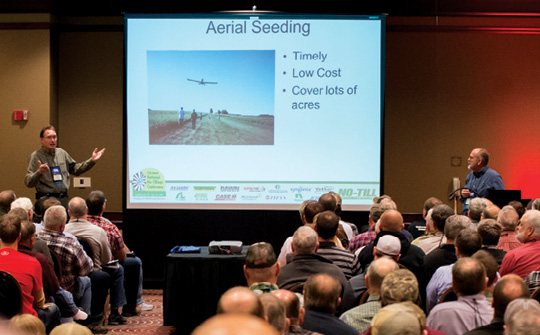At the recent National No-Till Conference in St. Louis, a number of people were acknowledged for their contributions to agriculture. Mike Plumer was among them, and his recognition is well deserved. If there is ever a candidate for the Cover Crop Hall of Fame, Plumer is it.
Mike has made a career out of helping others, whether as an Extension Agent, Natural Resources Educator, Agronomist or Crop Consultant. Even during his 34 years working for the University of Illinois, he was also farming his own land, researching and testing ideas on his own crops.
Since leaving the University, he has been at the forefront of cover crop innovation. It was he who managed the early field trials of annual ryegrass, when it astonished growers and academics about annual ryegrass’ deep rooting and compaction busting properties.
He started and continues to work with the Illinois Council on Best Management Practices. He was on the ground floor with the Midwest Cover Crop Council. He has helped thousands of growers learn quickly how to employ cover crops in various states, different climates and with many different soil properties. He has given selflessly to big and small audiences, from the Midwest to both U.S. coasts, and from Austria to South Africa.
In recent years, as more government agencies and nonprofit environmental organizations began to recognize the value of cover crops, Mike was a consultant and patient guide in their steep learning curve. He has been a tireless advocate and champion of cover crops in whatever setting he finds himself.
With Mike’s consistent effort, the word spread quickly about cover crop benefits. From only hundreds of acres in cover crops during the 1990s when he began his push for use of annual ryegrass as a cover crop, the number of farms using cover crops has grown geometrically. Recent estimates indicate that between 2 and 4 million acres in the Midwest are planted in cover crops each year. The increases, year over year, indicate that the growth curve is not abating. SARE and the CTIC surveyed farmers and they said there was a 37.75 percent increase in cover crop acres from 2012 to 2013 alone. And according to Practical Farmers of Iowa, the increase in cover crop seed flown onto to farmland grew 200 percent increase between 2010 and 2013.
But Mike has also been a keen observer of best practices and has continued to caution and educate people about making small steps to increase their chances of success. In a quote from a National Wildlife Federation publications on cover crop management, Mike said, “It’s important for farmers to have the right help when they are starting out with cover crops. Because cover crops require a totally different set of management skills to be successful.”
Congratulations, Mike. And thank you.








